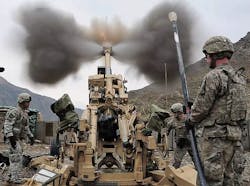Army and Navy to develop prototype artillery smart munition able to hit moving targets without GPS
Officials of the U.S. Office of Naval Research (ONR) in Arlington, Va., issued a special notice this week (N00014-18-R-SN06) for the Moving Target Artillery Round (MTAR) program. ONR issued the notice together with the U.S. Army Armament Research, Development, and Engineering Center at Picatinny Arsenal, N.J.
MTAR is to be an extended-range guided projectile capable of engaging stationary and moving targets on land and at sea, including engagements that cannot rely on Global Positioning System (GPS) satellite navigation to enhance the shell's accuracy.
Army, Navy, and U.S. Marine Corps ordnance experts will use inert and live-fire prototype flight tests with the M777A2 155-millimeter towed Howitzer to demonstrate technological maturity of the system before switching MTAR to a program at the Marine Corps Systems Command at Quantico Marine Base, Va.
Key features of the MTAR shell include extended range, effectiveness against moving targets, precision guidance and navigation without GPS, subsystem modularity, subsystem maturity, weapon system compatibility, restricted altitude, all-weather capability, reduced time of flight, and affordability.
The new smart munition would be for any Army or Marine Corps M777A1 howitzer, the M109A6 Paladin, and M109A7 Paladin Integrated Management (PIM) self-propelled 155-millimeter artillery systems. The shell also would be for the Navy's Advanced Gun System (AGS) aboard the Zumwalt-class destroyer, as well as for other future naval gun systems.
Army and Navy experts were to brief industry on the MTAR prototyping effort today in Arlington, Va. Companies interested in devising MTAR shell prototypes must be members of the U.S. National Armaments Consortium (NAC) in Summerville, S.C.
Companies interested should respond to the NAC-only Website no later than 15 May 2018 at https://login.ati.org. Non-members can get more information about joining by email at [email protected].
For questions or concerns contact the Navy's Dan Simons by email at [email protected], or by phone at 703-696-4840. Also contact Lesley Wilhelm by email at [email protected], or by phone at 301-744-1705.
More information is online either at www.nac-dotc.org/opportunities.html, or at https://www.fbo.gov/spg/DON/ONR/ONR/N00014-18-R-SN06/listing.html.
Ready to make a purchase? Search the Military & Aerospace Electronics Buyer's Guide for companies, new products, press releases, and videos
